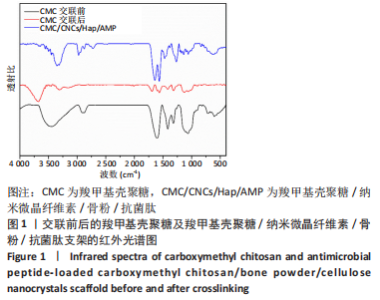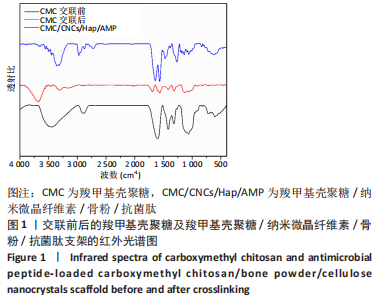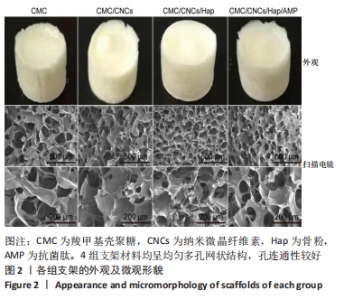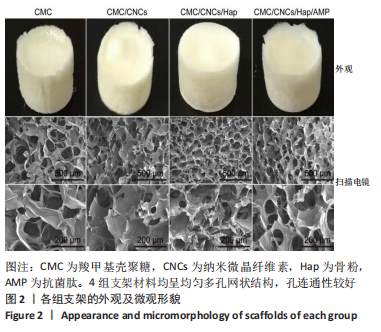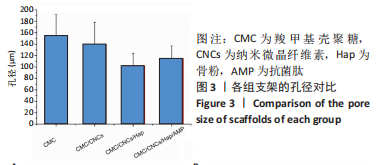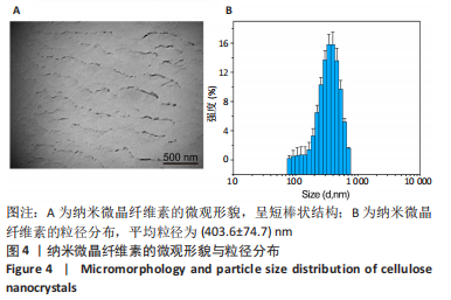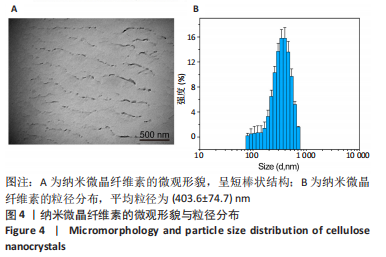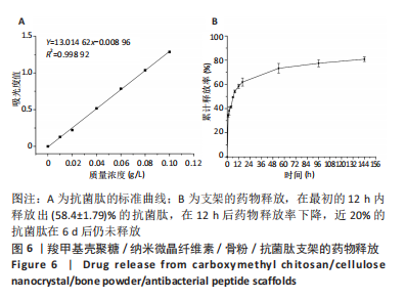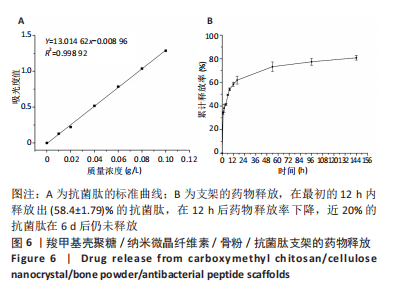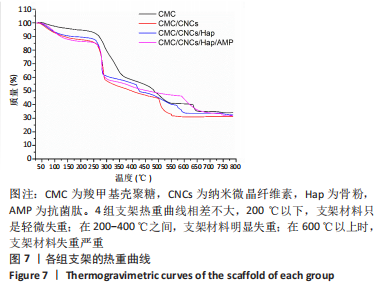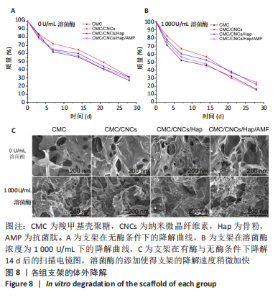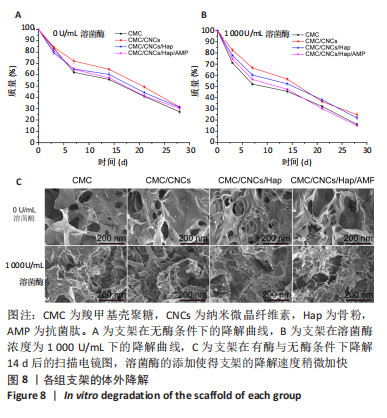Chinese Journal of Tissue Engineering Research ›› 2023, Vol. 27 ›› Issue (25): 3999-4005.doi: 10.12307/2023.412
Previous Articles Next Articles
Physicochemical properties of chitosan/bone powder/cellulose nanocrystals scaffold loaded with antimicrobial peptides for jaw repair
Yu Aimin, Xu Ting, Zhu Yunying, Liang Jianqiang, Wu Donghui
- Stomatology Hospital of Haizhu district, Guangzhou 510405, Guangdong Province, China
-
Received:2022-04-20Accepted:2022-06-13Online:2023-09-08Published:2023-01-17 -
Contact:Wu Donghui, Associate chief physician, Stomatology Hospital of Haizhu district, Guangzhou 510405, Guangdong Province, China -
About author:Yu Aimin, Master, Stomatology Hospital of Haizhu district, Guangzhou 510405, Guangdong Province, China -
Supported by:Science and Technology Project of Haizhu District of Guangzhou, No. 2018-38 (to WDH)
CLC Number:
Cite this article
Yu Aimin, Xu Ting, Zhu Yunying, Liang Jianqiang, Wu Donghui. Physicochemical properties of chitosan/bone powder/cellulose nanocrystals scaffold loaded with antimicrobial peptides for jaw repair[J]. Chinese Journal of Tissue Engineering Research, 2023, 27(25): 3999-4005.
share this article
Add to citation manager EndNote|Reference Manager|ProCite|BibTeX|RefWorks

2.4 各组支架吸水率测试结果 4种支架的吸水率测试结果见图5A。羧甲基壳聚糖、羧甲基壳聚糖/纳米微晶纤维素、羧甲基壳聚糖/纳米微晶纤维素/骨粉、羧甲基壳聚糖/纳米微晶纤维素/骨粉/抗菌肽支架的吸水率的分别为(728.6±24.7)%,(656.2±19.3)%,(604.9±23.5)%,(698.8±53.8)%。 2.5 各组支架力学性能测试结果 4种支架的拉伸强度、断裂伸长率和压缩强度-应变曲线,见图5B-D。4种支架的抗拉强度范围为0.7-0.9 MPa,断裂伸长率都在8%-10%之间,相互之间的差异较小。羧甲基壳聚糖/纳米微晶纤维素/骨粉和羧甲基壳聚糖/纳米微晶纤维素/骨粉/抗菌肽支架的抗拉强度相比另外两种支架有一定的升高。压缩强度-应变曲线显示,4种支架都有良好的柔韧性,随着应力的增大,都产生了较大的形变。"
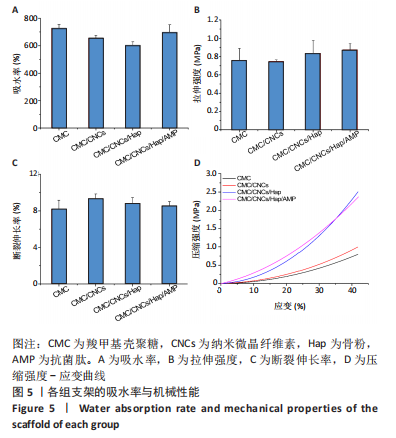
| [1] PACELLI S, BASU S, WHITLOW J, et al. Strategies to develop endogenous stem cell-recruiting bioactive materials for tissue repair and regeneration. Adv Drug Deliv Rev. 2017;120:50-70. [2] YU X, TANG X, GOHIL SV, et al. Biomaterials for bone regenerative engineering. Adv Healthc Mater. 2015;4(9):1268-1285. [3] KHOURY F, HANSER T. Mandibular Bone Block Harvesting from the Retromolar Region: A 10-Year Prospective Clinical Study. Int J Oral Maxillofac Implants. 2015;30(3):688-697. [4] SAKKAS A, WILDE F, HEUFELDER M, et al. Autonomic bone grafts in oralimplantology-is it still a “gold standard”? A consecutive review of 279 patients with 456 clinical procedures. Int J Implant Dent. 2017; 3(1):1-17. [5] YUNOS DM, BRETCANU O, BOCCACCINI AR. Polymer bioceramic composites for tissue engineering scaffolds. J Mater Sci. 2008;43(13): 4433-4442. [6] FU Q, SAIZ E, TOMSIA AP. Bioinspired strong and highly porous glass scaffolds. Adv Funct Mater. 2011;21(6):1058-1063. [7] 高文伟,孙丽莹,张泽天,等.生物质基含硅骨修复复合支架材料的制备、特性及评价[J].化工进展,2019,38(10):4595-4605. [8] BORDEA IR, CANDREA S, ALEXESCU GT, et al. Nano-hydroxyapatite use in dentistry: a systematic review. Drug Metab Rev. 2020;52(2):319-332. [9] HABRAKEN W, HABIBOVIC P, EPPLE M, et al. Calcium phosphates in biomedical applications: materials for the future? Mater Today. 2016; 19(2):69-87. [10] 仇旭童,饶晨煜,李婷,等.骨组织工程中纳米羟基磷灰石的仿生合成研究进展[J].四川大学学报,2021,52(3):1-7. [11] YOSHIKAWA H, TAMAI N, MURASE T, et al.Interconnected porous hydroxyapatite ceramics for bone tissue engineering. J R Soc Interface. 2009;6(3):341-348. [12] EPPLE M. Review of potential health risks associated with nanoscopic calcium phosphate. Acta Biomater. 2018;77:1-14. [13] MUZZARELLI RA. Chitins and chitosans for the repair of wounded skin, nerve,cartilage and bone. Carbohydr Polym. 2009;76(2):167-182. [14] WANG G, LU G, QIANG A, et al. Preparation of cross-linked carboxymethyl chitosan for repairing sciatic nerve injury in rats. Biotechnol Lett. 2010;32(1):59-66. [15] SLAVCHOV RI, Novev JK. Surface tension of concentrated electrolyte solutions. J Colloid Interf Sci. 2012;387(1):234-243. [16] LIU X, MILLER AL, PARK S, et al. Functionalized carbon nanotube and graphene oxide embedded electrically conductive hydrogelsynergistically stimulates nerve cell differentiation. ACS Appl Mater Interfaces. 2017;9(17):14677-14690. [17] GUO J, LIU J, QIE H, et al. Efficient synthesis strategy of folate-modified carboxymethyl chitosan (FCMC)/CaCO3 hybrid nanospheres and their drug-carrying and sustained release properties. J Biomater Sci Polym Ed. 2021;32(6):799-812. [18] 韩冬琳,亓洪昭,赵瑾,等.增强纳米药物载体肿瘤内渗透分布的研究进展[J].化学进展,2016,28(9):1397-1405. [19] LIN CC, LIN CW. Preparation of N, O-carboxymethyl chitosan nanoparticles as an insulin carrier. Drug Deliv. 2009;16(8):458-464. [20] DE TULLIO I, CAPUTI S, PERFETTI G, et al. A human clinical and histomorphometrical study on dDifferent resorbable and nonResorbable bone substitutes used in post-eExtractive sites. Materials (Basel). 2019;12(15):2408. [21] LI Z, DU T, RUAN C, et al. Bioinspired mineralized collagen scaffolds for bone tissue engineering. Bioact Mater. 2021;6(5):1491-1511. [22] 孙溪饶,包佳昕,王程越.壳聚糖/矿化胶原多孔支架构建及体外成骨分化与生物相容性[J].中国组织工程研究,2022,26(34):5498-5503. [23] NIZAN N, ZULKIFLI FH. Reinforcement of hydroxyethyl cellulose/poly (vinyl alcohol) with cellulose nanocrystal as a bone tissue engineering scaffold. J Polym Res. 2020;27(6):1-9. [24] SULAIMAN S, MOKHTAR MN, NAIM MN, et al. Penghasilan nano-gentian selulosa (CNF) diperolehi daripada gentian kulit kenaf dan potensinya sebagai penyokong pemegunan enzim. Malay J Anal Sci. 2016;20:309-317. [25] DAVOUDPOUR Y, HOSSAIN MS, ABDUL KHALIL HPS, et al. Optimization of high pressure homogenization parameters for the isolation of cellulosic nanofifibers using response surface methodology. Ind Crop Prod. 2015;74:381-387. [26] KAZEMZADEH-NARBAT M, WANG Q, HANCOCK R, et al. Antimicrobial Peptide Delivery from Trabecular Bone Grafts. J Biomater Tissue Eng. 2014;4(11):967-972. [27] ZHANG C, WANG J, FENG H, et al. Replacement of segmental bone defects using porous bioceramic cylinders: A biomechanical and X-ray diffraction study. J Biomed Mater Res B Appl Biomater. 2015;54(3): 407-411. [28] PETER M, GANESH N, SELVAMURUGAN N, et al. Preparation and characterization of chitosan gelatin/nanohydroxyapatite composite scaffolds for tissue engineering applications. Carbohydr Polym. 2010; 80(3):687-694. [29] KARAGEORGIOU V, KAPLAN D. Porosity of 3D biomaterial scaffolds and osteogenesis. Biomaterials. 2005;26(27):5474-5491. [30] 李博,王硕,赵勇刚,等.仿生矿化胶原骨材料用于儿童颅骨再生修复的最新研究进展[J].中国修复重建外科杂志,2021,35(3):278-285. [31] 樊鹏,江雨棋,张涛,等.壳聚糖管状组织工程复合支架制备及性能研究[J].合成材料老化与应用,2018,47(6):31-35. [32] 毕博,臧圣奇,何懋典,等.还原氧化石墨烯修饰壳聚糖骨组织工程支架的制备及表征[J].医学研究生学报,2021,34(4):350-356. [33] MANGANO C, MANGANO F, GOBBI L, et al. Comparative study between laser light stereolithography 3D printed and traditionally sintered biphasic calcium phosphate scaffolds by an integrated morphological, morphometric and mechanical analysis. Int J Mol Sci. 2019;20(13):3118-3134. [34] 尹擘,阎景龙.自体微小颗粒骨复合红骨髓修复节段性骨缺损的实验研究[J].哈尔滨医科大学学报,2002,36(6):448-450+502. [35] HASIREI V, LEWANDROWSKI K, GRESSER JD, et al.Versatility of biodegradable biopolymers:degradability and an in vivo application. J Biotechn. 2001;86(2):135-150. [36] JOHNSON CT, GARCIA AJ. Scaffold-based anti-infection strategies in bones repair. Ann Biomed Egg. 2015;43(3):515-528. [37] LU H, LIU Y, GUO J, et al.Biomaterials with antibacterial and osteoinductive properties to repair infected bone defects. Int J Mol Sci. 2016;17(3):334. [38] 伍家毅,李巍明,李夏林,等.抗菌人工骨支架材料研究进展[J].国际骨科学杂志,2021,42(3):162-165. |
| [1] | Lai Pengyu, Liang Ran, Shen Shan. Tissue engineering technology for repairing temporomandibular joint: problems and challenges [J]. Chinese Journal of Tissue Engineering Research, 2025, 29(在线): 1-9. |
| [2] | Li Shuai, Liu Hua, Shang Yonghui, Liu Yicong, Zhao Qihang, Liu Wen. Stress distribution on the maxilla when wearing the Twin-block appliance for Class II malocclusion [J]. Chinese Journal of Tissue Engineering Research, 2025, 29(5): 881-887. |
| [3] | Yu Shuangqi, Ding Fan, Wan Song, Chen Wei, Zhang Xuejun, Chen Dong, Li Qiang, Lin Zuoli. Effects of polylactic acid-glycolic acid copolymer/lysine-grafted graphene oxide nanoparticle composite scaffolds on osteogenic differentiation of MC3T3 cells [J]. Chinese Journal of Tissue Engineering Research, 2025, 29(4): 707-712. |
| [4] | Wang Zilin, Mu Qiuju, Liu Hongjie, Shen Yuxue, Zhu Lili. Protective effects of platelet-rich plasma hydrogel on oxidative damage in L929 cells [J]. Chinese Journal of Tissue Engineering Research, 2025, 29(4): 771-779. |
| [5] | Li Mingzhe, Ye Xiangling, Wang Bing, Yu Xiang. Preparation and osteogenic properties of liquid crystal display light-cured polylactic acid scaffold loaded with nano-tantalum [J]. Chinese Journal of Tissue Engineering Research, 2025, 29(4): 670-677. |
| [6] | Xiao Fang, Huang Lei, Wang Lin. Magnetic nanomaterials and magnetic field effects accelerate bone injury repair [J]. Chinese Journal of Tissue Engineering Research, 2025, 29(4): 827-838. |
| [7] | Zhang Yu, Xu Ruian, Fang Lei, Li Longfei, Liu Shuyan, Ding Lingxue, Wang Yuexi, Guo Ziyan, Tian Feng, Xue Jiajia. Gradient artificial bone repair scaffold regulates skeletal system tissue repair and regeneration [J]. Chinese Journal of Tissue Engineering Research, 2025, 29(4): 846-855. |
| [8] | Lin Xiaohui, Yang Mengyuan, Li Chunnian. Role and mechanism of biomimetic remineralization therapy for early enamel demineralization [J]. Chinese Journal of Tissue Engineering Research, 2025, 29(4): 856-865. |
| [9] | Tian Jiayu, Li Duohua, Zhang Feng, Feng Hu, Sun Wei. Construction and performance evaluation of polycaprolactone/nanodiamond-phospholipid composite materials [J]. Chinese Journal of Tissue Engineering Research, 2025, 29(16): 3380-3387. |
| [10] | Li Yonghang, Li Wenming, Yan Caiping, Wang Xingkuan, Xiang Chao, Zhang Yuan, Jiang Ke, Chen Lu. Critical bone defect repaired with anti-fibrosis and “H”-type core-shell bionic scaffold [J]. Chinese Journal of Tissue Engineering Research, 2025, 29(16): 3420-3431. |
| [11] | Ma Lisha, He Huiyu, Wufanbieke·Baheti, Lyu Shangyi, Han Xiangzhen. effect of graphene oxide/hydroxyapatite composite coating on immune activity of RAW264.7 macrophages [J]. Chinese Journal of Tissue Engineering Research, 2025, 29(10): 2023-2029. |
| [12] | Dumanbieke·Amantai, He Huiyu, Han Xiangzhen. Hydroxyapatite-graphene oxide composite coating promotes bone defect repair in rats [J]. Chinese Journal of Tissue Engineering Research, 2025, 29(10): 2030-2037. |
| [13] | Chen Jiahan, Feng Chao, Huang Xiaoxia, Niu Minghui, Wang Xin, Teng Yong. Two-dimensional black phosphorus materials for bone tissue engineering [J]. Chinese Journal of Tissue Engineering Research, 2025, 29(10): 2124-2131. |
| [14] | Wu Yaokun, Liu Chenglin, Fu Jiahao, Song Wei, Chen Hao, Xi Hongzhong, Liu Xin, Du Bin, Sun Guangquan. Combination of effective ingredients of traditional Chinese medicine and bone tissue engineering materials for bone repair [J]. Chinese Journal of Tissue Engineering Research, 2025, 29(10): 2141-2150. |
| [15] | Liu Yunxiang, Zhang Xiaoyu, Li Hao, Zhang Rong, Li Liping, Chen Chongwei. Multiple applications of metal-organic framework materials in bone tissue engineering and orthopedic disease treatment [J]. Chinese Journal of Tissue Engineering Research, 2025, 29(10): 2151-2161. |
| Viewed | ||||||
|
Full text |
|
|||||
|
Abstract |
|
|||||
